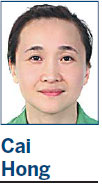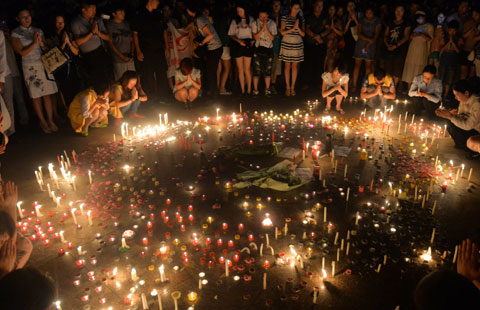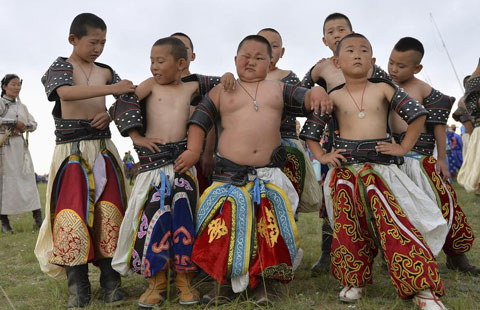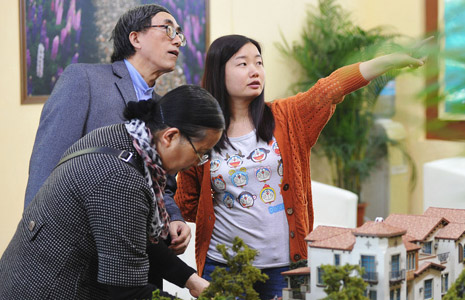A series of clumsy diplomatic dance moves
Updated: 2014-08-08 09:43
By Cai Hong (China Daily Europe)
|
|||||||||||

Trying to make gains in Russia or DPRK ties and whitewash its war history, Tokyo has stepped on the US' toes
US Vice-President Joe Biden rang Japanese Prime Minister Shinzo Abe on July 31, saying the White House welcomed Japan's announcement that it will impose more sanctions on Russia.
The Japanese plan was put in real terms on Aug 5 as the Abe Cabinet formally approved additional sanctions including the freezing of assets held in Japan by 40 people and two groups supporting the separation of Crimea from Ukraine, and a ban on Crimean imports. Japanese Chief Cabinet Secretary Yoshihide Suga said the steps are in line with measures taken by European Union and G7.
However, the Abe administration has been reluctant to impose sanctions because it has its own Russia policy. As Japan's ties with China and the Republic of Korea have chilled, Abe has been pursuing an amicable relationship with Russia in the hopes of ironing out their decades-long territorial dispute, driving a wedge between China and Russia and securing energy supplies. Japanese and Russian companies are pushing ahead with projects, including a liquefied natural gas facility in Sakhalin to increase shipments to Japan and other Asian countries.
Although the United States is soliciting support throughout the world for sanctions against Russia, Abe adamantly declared in a July 19 speech that he would continue to hold discussions with Russian President Vladimir Putin, and he has invited the Russian leader to visit Japan in the autumn.
But Abe's friendly diplomacy toward Russia has displeased the United States, which wants solidarity among the G7 countries when dealing with Russia.
The US is also unhappy about Abe's diplomacy toward the Democratic People's Republic of Korea.
After talks between Japanese and DPRK officials in Stockholm and Beijing, the DPRK agreed to reopen the investigation into Japanese nationals abducted by the DPRK in the 1970s and the 1980s in exchange for food and medical supplies. The DPRK is supposed to report its initial findings in late August or early September.
Abe immediately rewarded the DPRK by lifting some of Japan's sanctions on the isolated country.
Japan's Foreign Minister Fumio Kishida told the Upper House Foreign Affairs and Defense Committee of Japan's parliament on June 3 that Abe might visit Pyongyang to get "the most effective response" and "bring results". There was then heated speculation in Japan about a possible visit by Abe to Pyongyang in August.
But in a phone conversation with Kishida on July 7, US Secretary of State John Kerry warned Abe's trip could disturb the trilateral efforts of the US, Japan and the ROK to rein in the DPRK's nuclear program. He asked Japan to consult with the US in advance should Abe plan to visit Pyongyang and before lifting any more sanctions.
This was widely considered an indication that Washington was concerned about the recent developments in relations between Japan and the DPRK.
However, Abe is desperately seeking something to boost his waning popularity. The approval rating for his Cabinet has been on the slide since July 1, when he announced the decision to allow Japan the right to collective self-defense, which broke a post-war taboo and made it possible for Japan to send fighting troops overseas again.
Former Japanese prime minister Junichiro Koizumi might have been the inspiration for his latest moves.
The DPRK admitted to kidnapping Japanese nationals in 2002 when Koizumi made an unprecedented visit to the DPRK, and he returned to Tokyo with five people who had been abducted. Koizumi flew to Pyongyang again in 2004, returning with five children of abductees. Koizumi's flagging popularity soared after the two visits, though admittedly not for long.
The number of the Japanese abductees in the DPRK remains a mystery. It is estimated to be about 470 according to the Investigation Commission on Missing Japanese Probably Related to North Korea, a Tokyo-based citizens' group, but 860 as estimated by Japan's National Police Agency.
Abe has said a possible breakthrough on the issue might prompt him to call a snap election in September.
It is not just Abe's diplomacy that the US is unhappy with, the right-wing administration's attempts to whitewash Japan's past is also making many in the US uneasy.
In October last year, Kerry and US Defense Secretary Chuck Hagel made themselves example to Abe and his Cabinet members by paying their respects for fallen Japanese soldiers at a cemetery in Tokyo. Anyone with any sense knows they were sending the message that it should be this cemetery, rather than the controversial Yasukuni Shrine, where Japanese officials should go to honor those that died in war. But Abe chose to ignore their message and, instead, visited the Yasukuni Shrine in December.
Will Abe now fly to Pyongyang in defiance of the US warning? Will he insist on welcoming Putin in Tokyo in autumn?
Should Abe proceed with either or both these plans the divide that has appeared between the two allies will widen. Yet, however much Abe would like to break away from his country's post-war regime, which, in his words, was created by the US occupying forces, he cannot design Japan's diplomatic strategy without US consent.
Thus he is hopping from one horn to the other in his dilemma.
The author is Tokyo bureau chief of China Daily. Contact the writer at caihong@chinadaily.com.cn
(China Daily European Weekly 08/08/2014 page13)
Today's Top News
Putin bans agricultural imports from West
UK names 'China hand' as new envoy
China film looks to global audience
China to exclude Apple products
Dutch firm to take over MH370 search
Nanjing takes fresh approach to Youth Olympics
China to punish Chrysler, Audi over monopoly
Beijing boosts checks on foreigners
Hot Topics
Lunar probe , China growth forecasts, Emission rules get tougher, China seen through 'colored lens', International board,
Editor's Picks

|

|

|

|

|

|





